Data-Driven Evaluation of the Synergetic Development of Regional Carbon Emissions in the Yangtze River Delta
Abstract
1. Introduction
- (1)
- (2)
- (3)
- The key to achieving carbon neutrality is ensuring regional coordinated carbon emission reductions. Therefore, considering the different resource endowments and development degrees in different regions, carbon emission reduction policies must be formulated according to the local conditions.
2. Data and Methods
2.1. Research Process
2.2. Data Collection and Processing
2.2.1. Calculation of Carbon Emissions
2.2.2. Calculation of the Carbon Emission Intensity
2.2.3. Anti-Entropy Weight Method
2.3. Data Modeling
2.3.1. Subsystem Order Degree Model
2.3.2. Synergy Model of the Composite System
2.4. Data Application
3. Case Study
3.1. Introduction of the Research Case
3.2. Calculation Results and Analysis
Current Status of Carbon Emissions in the YRD
3.3. Carbon Emission Intensity in the YRD
3.4. Order Parameters of Carbon Emission Subsystems in the YRD
3.5. Synergetic Degree of Carbon Emission Systems in the YRD
3.6. Recommendations for Carbon Emission Reduction
3.6.1. Vigorously Develop Nuclear Power, Solar Energy, Wind Energy, and New Energy Vehicles to Reduce Carbon Emissions and Economic Dependence on Fossil Fuels
3.6.2. Innovate Production Technology and Reduce Carbon Emissions in Production Links
3.6.3. Strengthen Industrial Transfer and Agglomeration, and Further Strengthen Synergy among Carbon Emissions in the YRD
3.6.4. Build an Integrated Fiscal and Financial Support System in the YRD to Balance Regional Carbon Emissions
3.7. Discussion and Implications
4. Conclusions
Author Contributions
Funding
Data Availability Statement
Conflicts of Interest
References
- Ang, B.W. Decomposition analysis for policymaking in energy. Energy Policy 2004, 32, 1131–1139. [Google Scholar] [CrossRef]
- An, Y.; Zhou, D.; Yu, J.; Shi, X.; Wang, Q. Carbon emission reduction characteristics for China’s manufacturing firms: Implications for formulating carbon policies. J. Environ. Manag. 2021, 284, 112055. [Google Scholar] [CrossRef] [PubMed]
- Arshad, A.; Magdalena, R.; Balsalobre, L.D.; Vincent, H.V.N. An analysis of the impact of clean and non-clean energy consumption on economic growth and carbon emission: Evidence from PIMC countries. Environ. Sci. Pollut. Res. 2022, 29, 51442–51455. [Google Scholar]
- Hu, J.B.; Luo, Z.P.; Li, F. Prediction of China’s carbon emission intensity under the “carbon peak” target: Based on LSTM and Arima BP model. Sci. Financ. Econ. 2022, 2, 89–101. [Google Scholar]
- Du, Q.; Wang, X.; Li, Y.; Zou, P.X.; Han, X.; Meng, M. An analysis of coupling coordination relationship between regional economy and transportation: Empirical evidence from China. Environ. Sci. Pollut. Res. 2022, 29, 34360–34378. [Google Scholar] [CrossRef]
- Wang, J.; Yang, F.; Chen, K. Regional carbon emission evolution mechanism and its prediction approach: A case study of Hebei, China. Environ. Sci. Pollut. Res. 2019, 26, 28884–28897. [Google Scholar] [CrossRef]
- Tian, K.; Dietzenbacher, E.; Yan, B.; Duan, Y. Upgrading or downgrading: China’s regional carbon emission intensity evolution and its determinants. Energy Econ. 2020, 91, 104891. [Google Scholar] [CrossRef]
- Liang, Y.; Niu, D.; Zhou, W.; Fan, Y. Decomposition analysis of carbon emissions from energy consumption in Beijing-Tianjin-Hebei, China: A Weighted-Combination model based on logarithmic mean divisia index and shapely value. Sustainability 2018, 10, 2535. [Google Scholar] [CrossRef]
- Jotzo, F. Quantifying uncertainties for emission targets economics and environment. Aust. Natl. Univ. Work. Pap. 2006. Available online: https://EconPapers.repec.org/RePEc:anu:eenwps:0603 (accessed on 14 August 2022).
- Jotzo, F.; Pezzey, J.C. Optimal intensity targets for greenhouse gas emissions trading under uncertainty. Environ. Resour. Econ. 2007, 38, 259–284. [Google Scholar] [CrossRef]
- Greening, L.A.; Ting, M.K.; Davis, W.B. Decomposition of aggregate carbon intensity for freight: Trends from 10 OECD countries for the period 1971–1993. Energy Econ. 1999, 21, 331–361. [Google Scholar] [CrossRef]
- Chen, Y.; Wu, J. Changes in carbon emission performance of energy-intensive industries in China. Environ. Environ. Sci. Pollut. Res. 2022, 29, 43913–43927. [Google Scholar] [CrossRef] [PubMed]
- Sun, W.; Huang, C. Predictions of carbon emission intensity based on factor analysis and an improved extreme learning machine from the perspective of carbon emission efficiency. J. Clean. Prod. 2022, 338, 130414. [Google Scholar] [CrossRef]
- Zhang, Y.; Qin, Y.; Yan, W.; Zhang, J.P.; Zhang, L.J.; Lu, F.X.; Wang, X. Urban types and impact factors on carbon emissions from direct energy consumption of residents in China. Geogr. Res. 2012, 31, 345–356. [Google Scholar]
- Deng, J.; Liu, X.; Wang, Z. Characteristics analysis and factor decomposition based on the regional difference changes in China’s CO2 emission. J. Nat. Resour. 2014, 29, 189–200. [Google Scholar]
- Xia, S.; Zhao, Y.; Xu, X.; Wen, Q.; Cui, P.P.; Tang, W.M. Regional Inequality, Spatial-Temporal Pattern and Dynamic Evolution of Carbon Emission Intensity from Agriculture in China in the Period of 1997–2016. Resour. Environ. Yangtze Basin 2020, 29, 596–608. [Google Scholar]
- Jia, D.; Li, C.; Wang, Q. Decomposition of carbon emission and its decoupling analysis and prediction with economic development: A case study of industrial sectors in Henan Province. J. Clean. Prod. 2021, 321, 129019. [Google Scholar]
- Han, M.; Liu, W.; Xie, Y.; Jiang, W. Regional Disparity and Decoupling Evolution of China’s Carbon Emissions by Province. Resour. Sci. 2021, 43, 710–721. [Google Scholar]
- Kok, R.; Benders, R.M.; Moll, H.C. Measuring the environmental load of household consumption using some methods based on input-output energy analysis: A comparison of methods and a discussion of results. Energy Policy 2006, 34, 2744–2761. [Google Scholar] [CrossRef]
- Zeng, J.J.; Zhang, Z.Q.; Qu, J.S.; Li, Y.; Liu, L.; Dong, L. Analysis and Evaluation of Methods for Household Carbon Emissions Calculation. Prog. Geogr. 2012, 31, 1341–1352. [Google Scholar]
- Liu, Y.; Yang, C.; Cai, H. Provincial differences and factor decomposition of Total carbon emission and intensity in China. J. Hunan Univ. Technol. 2022, 36, 1–9. [Google Scholar]
- Chen, S. The pattern and economic explanation of China’s carbon emission intensity fluctuation decline. World Econ. 2011, 34, 124–143. [Google Scholar]
- Zhang, Y. The Impact of the change of economic development mode on China’s carbon emission intensity. Econ. Res. 2010, 45, 120–133. [Google Scholar]
- Sun, Z.; Zhou, D.; Zhou, P. Research on driving factors of industrial carbon emissions: A new production decomposition analysis method. Quant. Tech. Econ. Res. 2012, 29, 63–74. [Google Scholar]
- Lin, B.; Mao, D. Research on the Phased Characteristics of China’s carbon emission intensity decline. Financ. Res. 2014, 8, 101–117. [Google Scholar]
- Wang, S.; Mo, H.; Fang, C. Dynamic simulation and carbon peak of urban carbon emissions in the Pearl River Delta Urban agglomeration. Chin. Sci. Bull. 2022, 67, 670–684. [Google Scholar] [CrossRef]
- Tong, H.; Qu, W. Assessing China 2030 carbon emissions from fossil fuels: Based on system dynamics model. High Technol. Lett. Engl. Ed. 2015, 2, 178–184. [Google Scholar]
- Ansoff, H.I. Corporate Strategy: An Analytic Approach to Business Policy for Growth and Expansion; McGraw Hill: New York, NY, USA, 1965. [Google Scholar]
- Haken, H. An Introduction to Synergetics; Atomic Energy Press: Beijing, China, 1984. [Google Scholar]
- Meng, Q.; Han, W. Study on Coordination Degree Model of Composite System. J. Tianjin Univ. 2000, 4, 444–446. [Google Scholar]
- Guorong, L.I.; Minna, M.A.; Ding, Y. Analysis of Evaluation and Comparison about the Regional Economic Development in China. In Proceedings of the International Institute of Statistics & Management Engineering Symposium, IISMES, Dalian, China, 20–25 July 2010. [Google Scholar]
- Balazs, L.; Loef, L. Regional innovation systems in Hungary: The failing synergy at the national level. Reg. Stud. 2011, 45, 677–693. [Google Scholar]
- Chen, Z.; Zhang, W. Research on collaborative innovation of inter-regional industrial clusters: An empirical analysis based on Beijing–Tianjin–Hebei regional collaboration. Seeker 2017, 7, 80–85. [Google Scholar]
- Tian, M.; Zhang, Y.; Tang, Z. Research and enlightenment of typical National innovation and entrepreneurship development model. Sci. Sci. Manag. Sci. Technol. 2016, 37, 3–16. [Google Scholar]
- Yang, X.; Luo, W.; Tang, Z. An empirical study on the coordination degree of R&D personnel input-output complex system from a Three-Dimensional perspective. Sci. Technol. Prog. Policy 2018, 35, 9–14. [Google Scholar]
- Wu, X.; Wei, Q.; Gu, X. Research on synergy Degree measurement of collaborative Innovation. Soft Sci. 2015, 29, 45–50. [Google Scholar]
- Feng, Y.; Xu, J. Research on the coordination degree measurement of information ecosystem in social media environment. Library 2018, 6, 73–78. [Google Scholar]
- Koberg, C.S.; Detienne, D.R.; Heppard, K.A. An Empirical Test of Environmental, Organizational, and Process Factors Affecting Incremental and Radical Innovation. J. Inf. Technol. Manag. 2003, 14, 21–45. [Google Scholar] [CrossRef]
- Bi, K.; Sun, D. An empirical study on the synergistic development of product innovation and process innovation in manufacturing enterprises based on composite System Coordination Degree Model. Chin. Soft Sci. 2010, 30, 156–162,192. [Google Scholar]
- Zhang, Y.; Liang, Y.; Wu, J.; Sheng, Y.Y. A Measure Model for Synergy Degree Between Enterprise Internal Innovation and Industry-University-Research Cooperation Innovation and Its Application. J. Intell. 2018, 37, 193, 201–207. [Google Scholar]
- Liu, C.; Gao, M.; Zhu, G.; Zhang, C.; Zhang, P.; Chen, J.; Cai, W. Data driven eco-efficiency evaluation and optimization in industrial production. Energy 2021, 224, 120170. [Google Scholar] [CrossRef]
- Ding, H.; Liu, Y.; Zhang, Y.; Wang, S.; Guo, Y.; Zhou, S.; Liu, C. Data-driven evaluation and optimization of the sustainable development of the logistics industry: Case study of the Yangtze River Delta in China. Environ. Sci. Pollut. Res. 2022, 29, 68815–68829. [Google Scholar] [CrossRef]
- Liu, F.; Wang, C.; Zhang, Y.; Zhou, S.; Yang, Y.; Wu, X.; Hu, F.; Liu, C. Data-driven analysis and evaluation of regional agriculture for high-quality development of Anhui Province in the Yangtze River Delta. Environ. Sci. Pollut. Res. 2021, 29, 22490–22503. [Google Scholar] [CrossRef]
- Zhang, C.; Zhang, Z. Agglomeration effect and radiation effect of Carbon emission intensity at Provincial level in China. J. Environ. Sci. 2017, 37, 1178–1184. [Google Scholar]
- Sun, Y.; Qian, L.; Liu, Z. The carbon emissions level of China’s service industry: An analysis of characteristics and influencing factors. Environ. Dev. Sustain. 2021, 12. [Google Scholar] [CrossRef]
- Zhan, D. Allocation of carbon emission quotas among provinces in China: Efficiency, fairness and balanced allocation. Environ. Sci. Pollut. Res. 2022, 29, 21692–21704. [Google Scholar] [CrossRef] [PubMed]
- Kong, Y.; He, W. The path analysis of carbon emission reduction: A case study of the Silk Road Economic Belt. Environ. Eng. Res. 2020, 25, 71–79. [Google Scholar] [CrossRef]
- Tong, X.; Salman, T. The Spatiotemporal Evolution Pattern and Influential Factor of Regional Carbon Emission Convergence in China. Adv. Meterol. 2020, 2020, 4361570. [Google Scholar] [CrossRef]

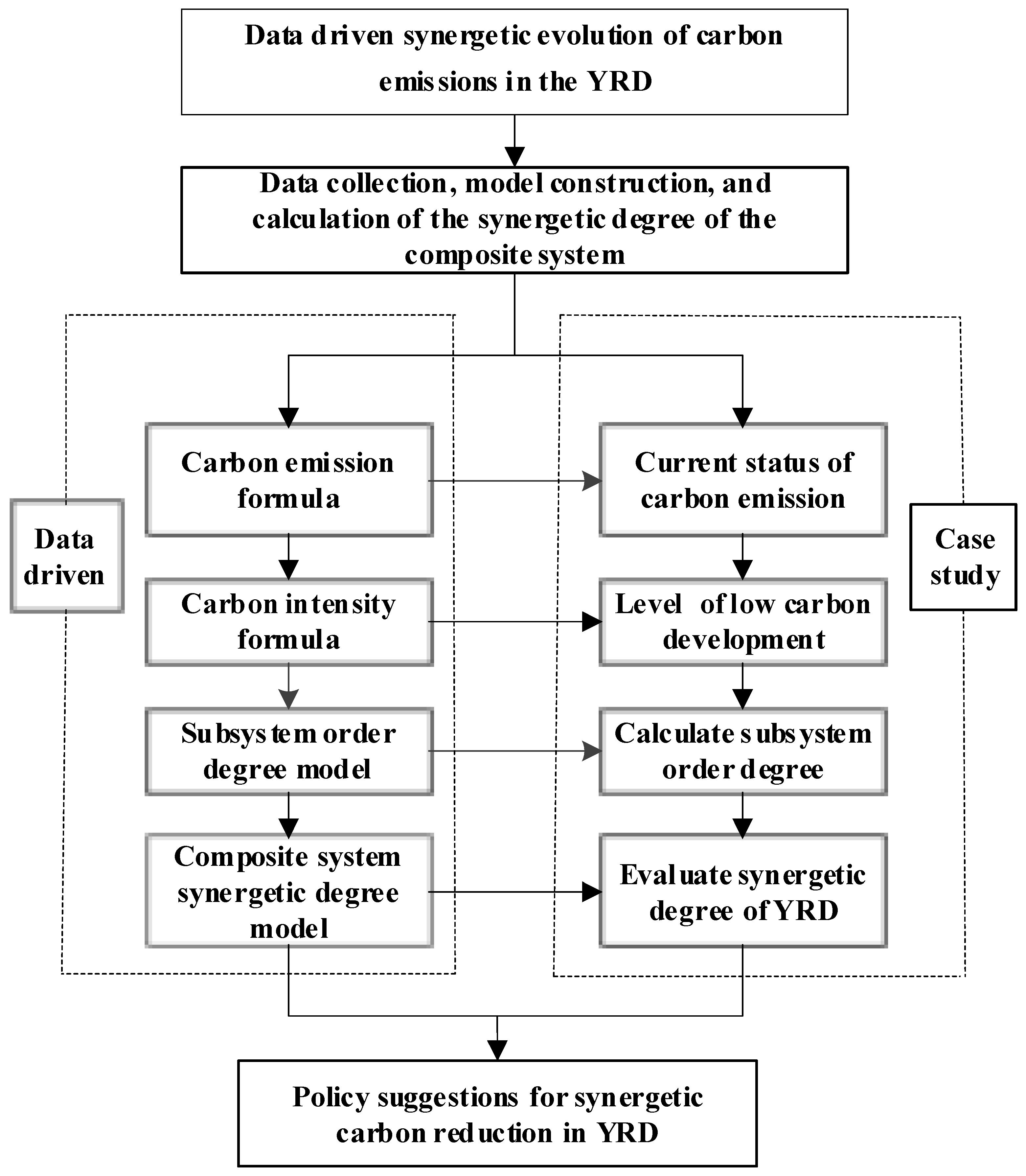
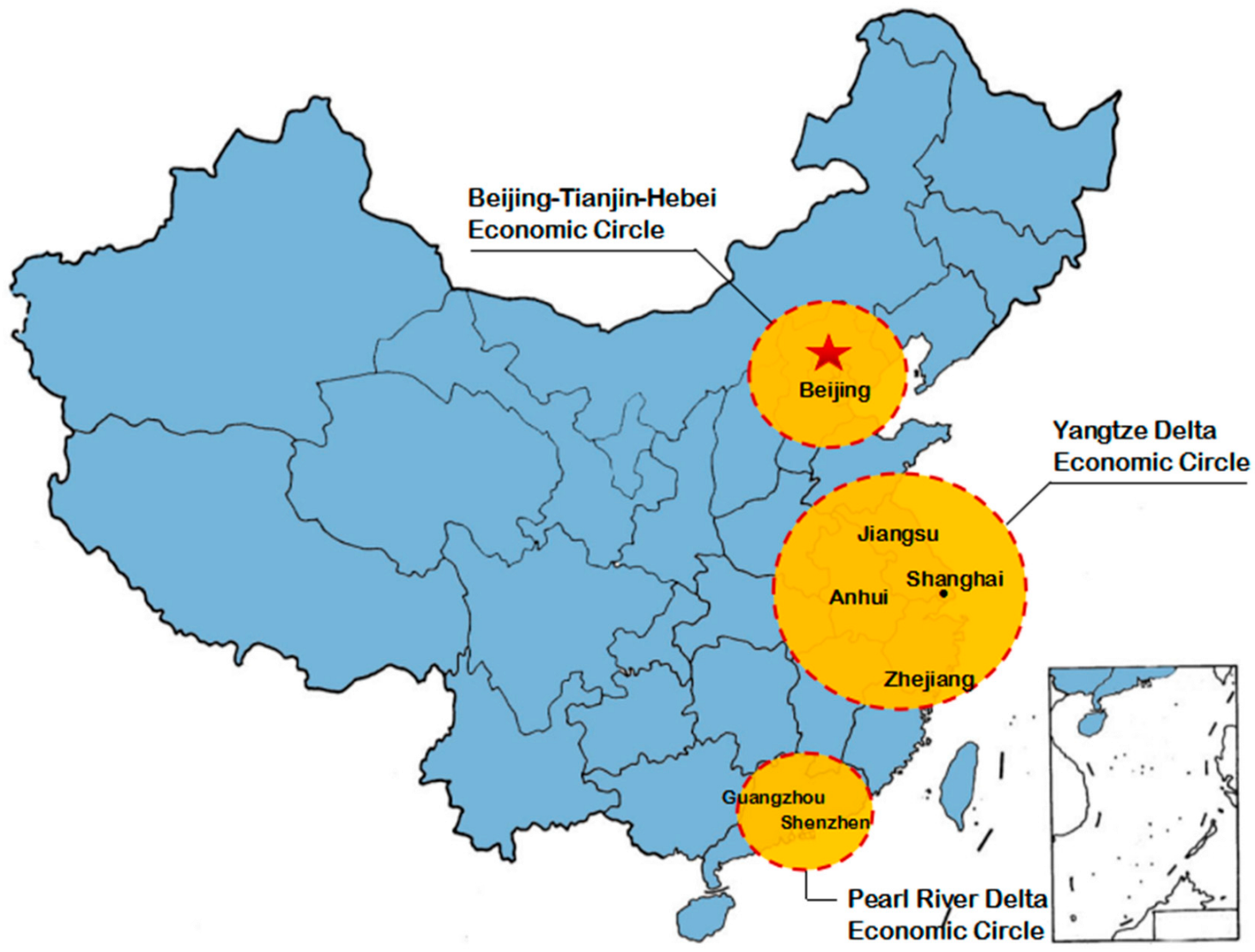
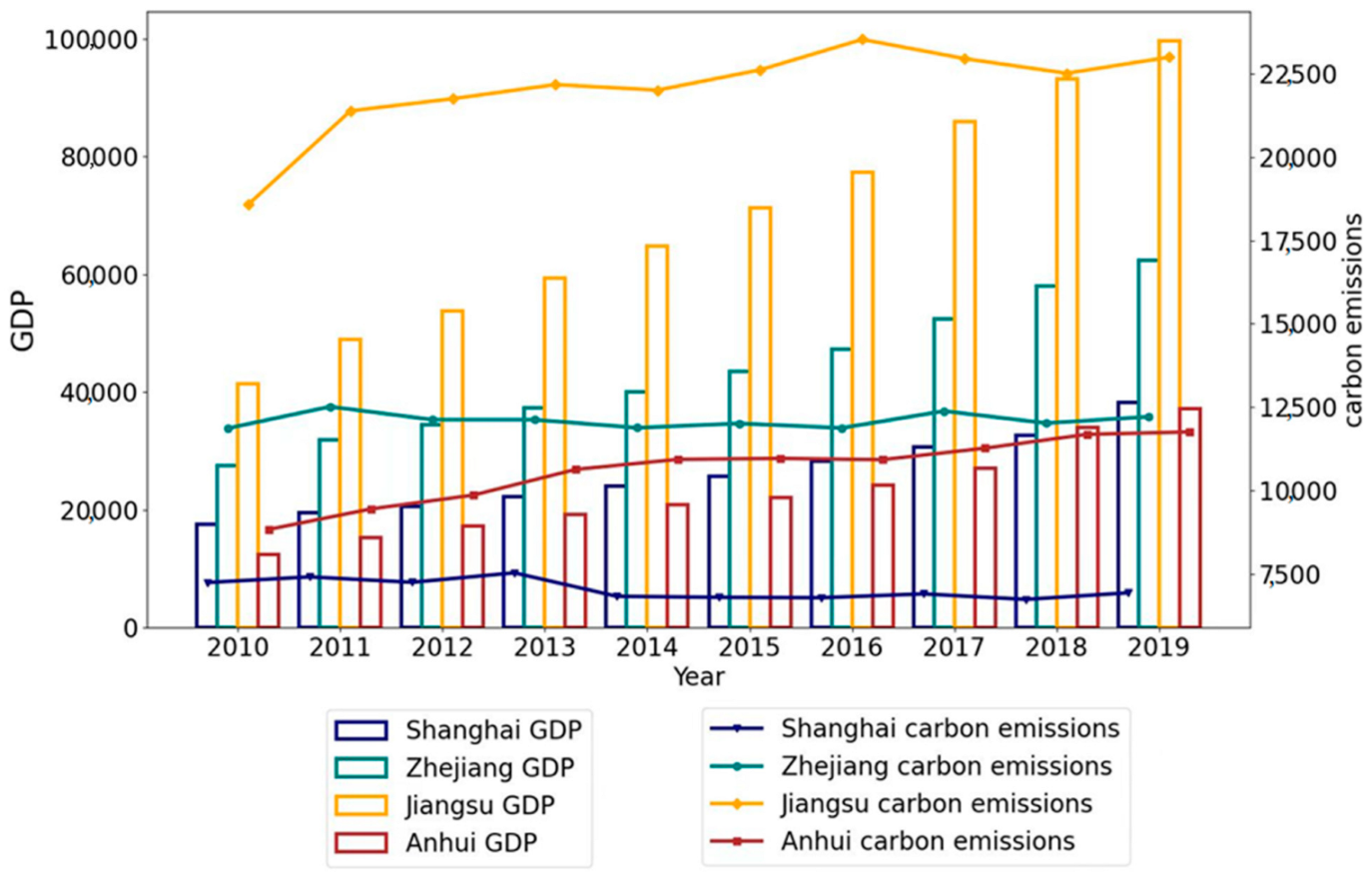
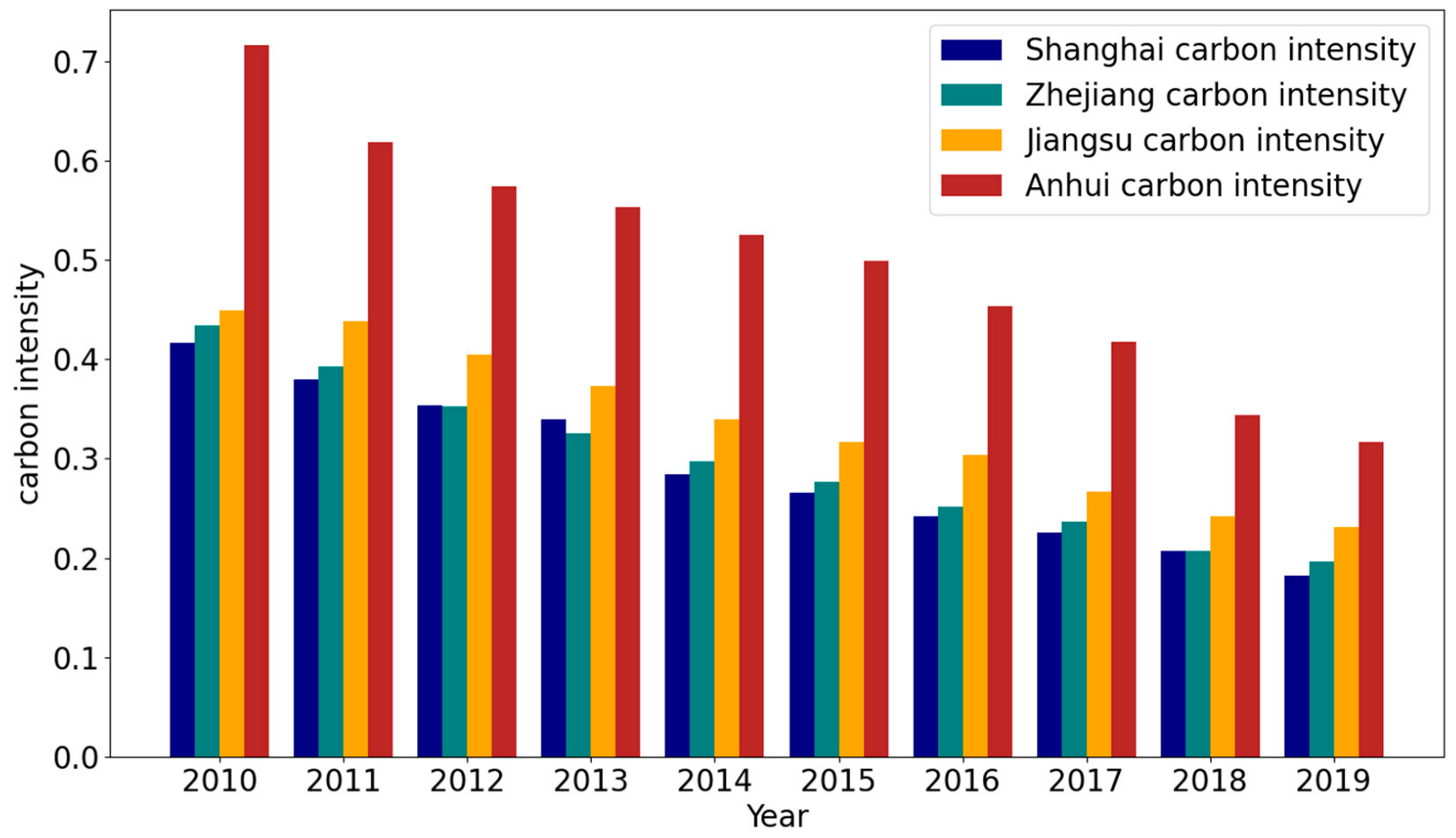

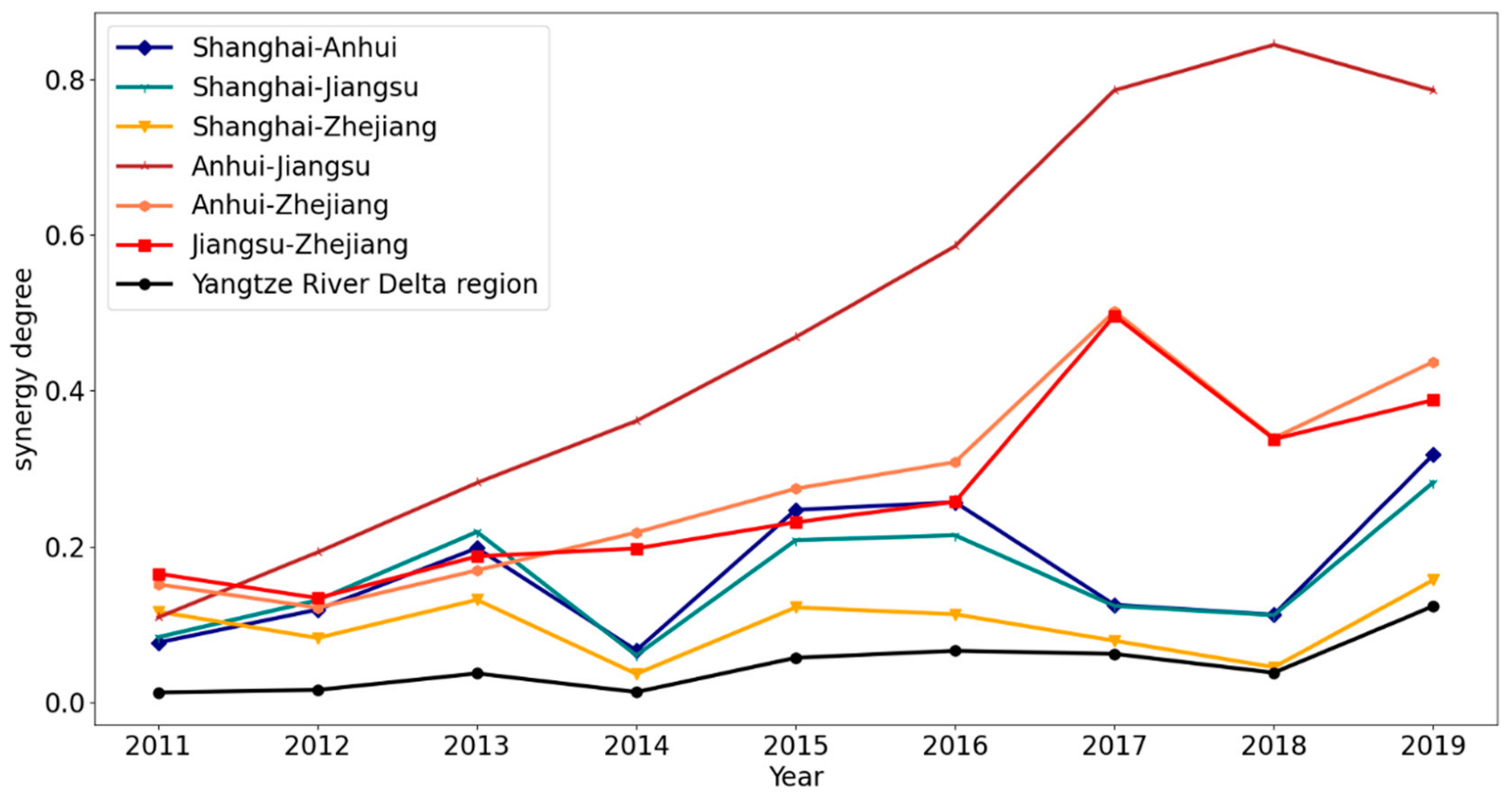
| Fossil Fuel | SCC | CEF |
|---|---|---|
| Coal | 0.7143 | 0.7559 |
| Coke | 0.9714 | 0.855 |
| Crude oil | 1.4286 | 0.5538 |
| Fuel oil | 1.4286 | 0.5857 |
| Gasoline | 1.4714 | 0.5921 |
| Kerosene | 1.4714 | 0.5714 |
| Diesel | 1.4571 | 0.6185 |
| Natural gas | 1.33 | 0.4483 |
| Year | Anhui | Jiangsu | Zhejiang | Shanghai |
|---|---|---|---|---|
| 2010 | 8846.950 | 18,571.628 | 11,873.326 | 7256.185 |
| 2011 | 9459.241 | 21,375.966 | 12,521.266 | 7425.207 |
| 2012 | 9872.958 | 21,738.425 | 12,130.304 | 7263.402 |
| 2013 | 10,641.626 | 22,160.282 | 12,128.956 | 7546.453 |
| 2014 | 10,943.858 | 21,995.723 | 11,888.570 | 6845.567 |
| 2015 | 10,969.509 | 22,599.579 | 12,018.669 | 6814.508 |
| 2016 | 10,934.197 | 23,512.397 | 11,882.851 | 6802.738 |
| 2017 | 11,277.668 | 22,938.507 | 12,388.863 | 6917.151 |
| 2018 | 11,693.712 | 22,498.586 | 12,026.430 | 6752.619 |
| 2019 | 11,762.771 | 22,982.034 | 12,218.804 | 6949.425 |
| Fossil Energy Emission Intensity in Anhui | Fossil Energy Emission Intensity in Jiangsu | Fossil Energy Emission Intensity in Zhejiang | Fossil Energy Emission Intensity in Shanghai |
|---|---|---|---|
| 0.716 | 0.449 | 0.433 | 0.416 |
| 0.618 | 0.438 | 0.393 | 0.380 |
| 0.574 | 0.405 | 0.353 | 0.353 |
| 0.553 | 0.373 | 0.325 | 0.339 |
| 0.525 | 0.339 | 0.297 | 0.284 |
| 0.498 | 0.317 | 0.276 | 0.266 |
| 0.453 | 0.304 | 0.251 | 0.241 |
| 0.417 | 0.267 | 0.236 | 0.226 |
| 0.344 | 0.241 | 0.207 | 0.207 |
| Year | Shanghai | Anhui | Jiangsu | Zhejiang |
|---|---|---|---|---|
| 2010 | 0.425 | 0.055 | 0.042 | 0.291 |
| 2011 | 0.484 | 0.155 | 0.160 | 0.498 |
| 2012 | 0.506 | 0.230 | 0.254 | 0.362 |
| 2013 | 0.578 | 0.310 | 0.353 | 0.401 |
| 2014 | 0.436 | 0.454 | 0.369 | 0.421 |
| 2015 | 0.315 | 0.612 | 0.436 | 0.438 |
| 2016 | 0.331 | 0.757 | 0.531 | 0.433 |
| 2017 | 0.405 | 0.850 | 0.819 | 0.610 |
| 2018 | 0.410 | 0.903 | 0.883 | 0.424 |
| 2019 | 0.539 | 0.940 | 0.739 | 0.528 |
| Shanghai–Anhui | Shanghai–Jiangsu | Shanghai–Zhejiang | Anhui–Jiangsu | Anhui–Zhejiang | Jiangsu–Zhejiang | Yangtze River Delta |
|---|---|---|---|---|---|---|
| 0.077 | 0.084 | 0.116 | 0.109 | 0.152 | 0.165 | 0.013 |
| 0.119 | 0.131 | 0.083 | 0.193 | 0.122 | 0.134 | 0.016 |
| 0.198 | 0.219 | 0.132 | 0.282 | 0.169 | 0.187 | 0.037 |
| 0.067 | 0.060 | 0.036 | 0.361 | 0.218 | 0.198 | 0.013 |
| 0.247 | 0.208 | 0.122 | 0.469 | 0.274 | 0.231 | 0.057 |
| 0.257 | 0.215 | 0.113 | 0.586 | 0.309 | 0.258 | 0.066 |
| 0.125 | 0.124 | 0.079 | 0.786 | 0.502 | 0.496 | 0.062 |
| 0.112 | 0.112 | 0.045 | 0.844 | 0.339 | 0.338 | 0.038 |
| 0.318 | 0.282 | 0.157 | 0.786 | 0.437 | 0.388 | 0.123 |
Publisher’s Note: MDPI stays neutral with regard to jurisdictional claims in published maps and institutional affiliations. |
© 2022 by the authors. Licensee MDPI, Basel, Switzerland. This article is an open access article distributed under the terms and conditions of the Creative Commons Attribution (CC BY) license (https://creativecommons.org/licenses/by/4.0/).
Share and Cite
Guo, Y.; Hu, F.; Xie, J.; Liu, C.; Yang, Y.; Ding, H.; Wu, X. Data-Driven Evaluation of the Synergetic Development of Regional Carbon Emissions in the Yangtze River Delta. Processes 2022, 10, 2236. https://doi.org/10.3390/pr10112236
Guo Y, Hu F, Xie J, Liu C, Yang Y, Ding H, Wu X. Data-Driven Evaluation of the Synergetic Development of Regional Carbon Emissions in the Yangtze River Delta. Processes. 2022; 10(11):2236. https://doi.org/10.3390/pr10112236
Chicago/Turabian StyleGuo, Yuxia, Fagang Hu, Jun Xie, Conghu Liu, Yaliu Yang, Heping Ding, and Xue Wu. 2022. "Data-Driven Evaluation of the Synergetic Development of Regional Carbon Emissions in the Yangtze River Delta" Processes 10, no. 11: 2236. https://doi.org/10.3390/pr10112236
APA StyleGuo, Y., Hu, F., Xie, J., Liu, C., Yang, Y., Ding, H., & Wu, X. (2022). Data-Driven Evaluation of the Synergetic Development of Regional Carbon Emissions in the Yangtze River Delta. Processes, 10(11), 2236. https://doi.org/10.3390/pr10112236







